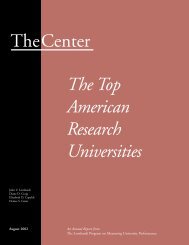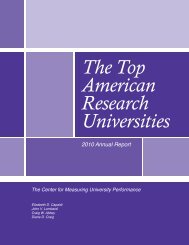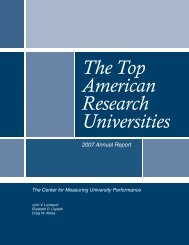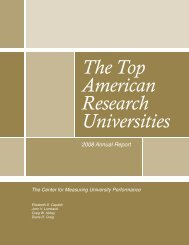TheCenter The Top American Research Universities
2005 - The Center for Measuring University Performance - Arizona ...
2005 - The Center for Measuring University Performance - Arizona ...
You also want an ePaper? Increase the reach of your titles
YUMPU automatically turns print PDFs into web optimized ePapers that Google loves.
Source Notes<strong><strong>The</strong>Center</strong> MeasuresTotal <strong>Research</strong> ExpendituresFederal <strong>Research</strong> ExpendituresSource: NSF/SRS Survey of R&D Expenditures at<strong>Universities</strong> and Colleges, FY 2003.Each year, the National Science Foundation (NSF)collects data from hundreds of academic institutionson expenditures for research and development inscience and engineering fields and classifies them bysource of funds (e.g., federal government, state andlocal government, industry, etc.). <strong>The</strong>se data are theprimary source of information on academic researchand development (R&D) expenditures in the UnitedStates. Included in this survey are all activities specificallyorganized to produce research outcomesthat are separately budgeted and accounted for. This“organized research” may be funded by an externalagency or organization (“sponsored research”) or bya separately budgeted organizational unit within theinstitution (“university research”). This report excludesactivities sponsored by external agencies that involveinstruction, training (except training in research techniques,which is considered organized research), andhealth service, community service, or extension serviceprojects.All Federally Funded <strong>Research</strong> Labs (FFRLs) areexcluded from these academic expenditures data, includingthe following: Jet Propulsion Laboratory (CaliforniaInstitute of Technology); Los Alamos NationalLab, Lawrence Livermore Lab, Lawrence BerkeleyLab (University of California); Software EngineeringInstitute (Carnegie Mellon); Argonne National Laboratory(University of Chicago); National Astronomyand Ionospheric Center (Cornell); Ames Laboratory(Iowa State University); Lincoln Laboratory (MIT);Plasma Physics Lab (Princeton); and Linear AcceleratorCenter (Stanford). <strong>The</strong> NSF data no longer classifythe Applied Physics Lab (APL) at Johns Hopkins as anFFRL, but federal funds support the vast majority ofresearch conducted there. <strong>The</strong> APL makes up nearlyone-half of Johns Hopkins’ total R&D expendituresand 53 percent of its federal R&D expenditures.While inconsistencies in reporting (known andunknown) do exist here, as in any survey of this type,problems arise mostly when one breaks out the databy source of funds. NSF expects institutions to useyear-end accounting records to complete this report,and there are nationally recognized accounting guidelinesfor higher education institutions. However, thereare also countless variations in institutional policy thatdetermine whether the university reports a particularexpenditure as coming from one source or another, orpossibly not counted at all. Take federal formula fundsfor agriculture (e.g., Hatch-McIntire, Smith-Lever) asan example. We conducted an informal survey of theappropriate institutions in the Association of <strong>American</strong><strong>Universities</strong> (AAU) and found that two out ofeleven land grants did not include any of these federalfunds in their 1997 NSF data, while others includedall or some of these monies. Because these funds makeup a very small percentage of the total research expendituresin any given year, the impact on our totalresearch rankings is slight. <strong>The</strong> agriculture formulafunds will have a somewhat greater, but still small,impact on the federal research rankings. NSF notes,“An increasing number of institutions have linkageswith industry and foundations via subcontracts, thuscomplicating the identification of funding source. Inaddition, institutional policy may determine whetherunrestricted state support is reported as state or asinstitutional funds.” 1We believe that the reporting inconsistencies in thedata are relatively minor when using the total researchexpenditures and the federal research expenditurescomponent. Federal and state government audits ofinstitutional accounting make deceptive practiceshighly unlikely, even though these entities do notaudit the NSF data directly. NSF goes to great lengthsto verify the accuracy of the data, especially federalexpenditure data—checking them against severalother federal agencies that collect the same or similarinformation. In fact, all major federal agencies andtheir subdivisions submit data to NSF identifyingresearch obligations to universities each year. Historically,the NSF data have tracked very closely the datareported by universities. 2 Further, for their NationalPatterns of R&D Resources series, NSF prefers to usethe figures reported by the performers of the work(that is, academic institutions, industry, nonprofits)because they believe that the performers are in thebest position to accurately report these expenditures.1. Academic R&D Expenditures, FY 2000: TechnicalNotes (On-line: http://www.nsf.gov/sbe/srs/nsf02308/secta.htm)2. National Patterns of R&D Resources, 1998: TechnicalNotes (On-line: http://www.nsf.gov/sbe/srs/nsf99335/appa.htm)<strong>The</strong> <strong>Top</strong> <strong>American</strong> <strong>Research</strong> <strong>Universities</strong> 2005 Page 229








